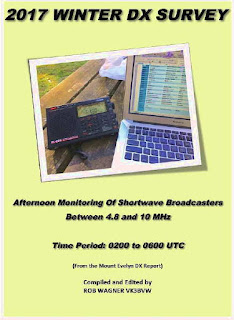 The VK3BVW Winter DX Survey
The VK3BVW Winter DX Survey
 |
| courtesy: VK3BVW |
Every once in awhile I get the yen to tune through the international SW broadcast bands as my interest in good old, basic SWL'ing, is rekindled.
These bands are certainly quieter compared to when I first discovered the magic of radio and started DXing at age eleven using a lovely old all band cathedral-style GE set up in my attic-high radio shack ... no longer just a boring attic bedroom, but one with walls plastered with QSLs from all over the world.
 It was an amazing experience and one that obviously has left a lasting impression. There were hundreds and hundreds of stations on SW, throughout all of the HF bands but the highest I could tune was 19mc. on the old General Electric beauty ... who knows what was missed up higher as this was the peak of Cycle 19 and HF was on fire!
It was an amazing experience and one that obviously has left a lasting impression. There were hundreds and hundreds of stations on SW, throughout all of the HF bands but the highest I could tune was 19mc. on the old General Electric beauty ... who knows what was missed up higher as this was the peak of Cycle 19 and HF was on fire!As the huge decline in international SW broadcasting over the past few years continues, I'm always pleasantly surprised to see that there are still a lot of nice DX targets to hunt for.
I was particularly excited to read Rob's (VK3BVW) just released blogspot, describing his fall listening project from down-under. Being the DX season down in Australia, Rob decided to do daily bandscans of the low HF international SW bands (4.8 - 10MHz) to see what popped-up from day to day, which was actually afternoon to afternoon, since his listening was done between noon and 4PM local time. The project may be viewed here along with a nice introductory video ... in all, a huge effort by Rob with a lot of helpful details to go along with the logs.
While there be sure to visit the rest of Rob's SW blog ... there's a lot of good stuff here to get your SWL juices flowing!
His survey results are very encouraging for those of us that may have thought that there is just not much to be heard when it comes to international SW broadcasting. As Rob points out, even though these logs reflect what was heard in Australia, most, if not all should be hearable in North America as well, even more so as we approach the DX season in North America.
So pull up your chair sometime after dark, grab a cup of your favorite beverage, and take a relaxing tune through the SW bands with Rob's list in hand ... see what you can find, and perhaps rekindle that early fascination in SW radio outside of the ham bands that may have hooked you many years ago. You may also find this broadcast frequency database helpful should you run across something unknown.













